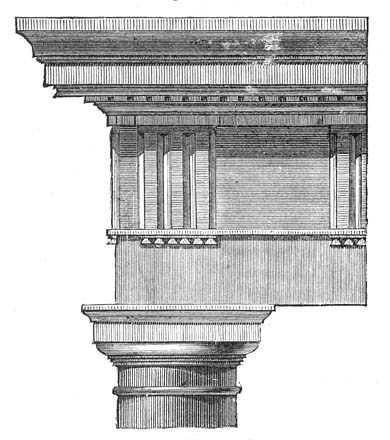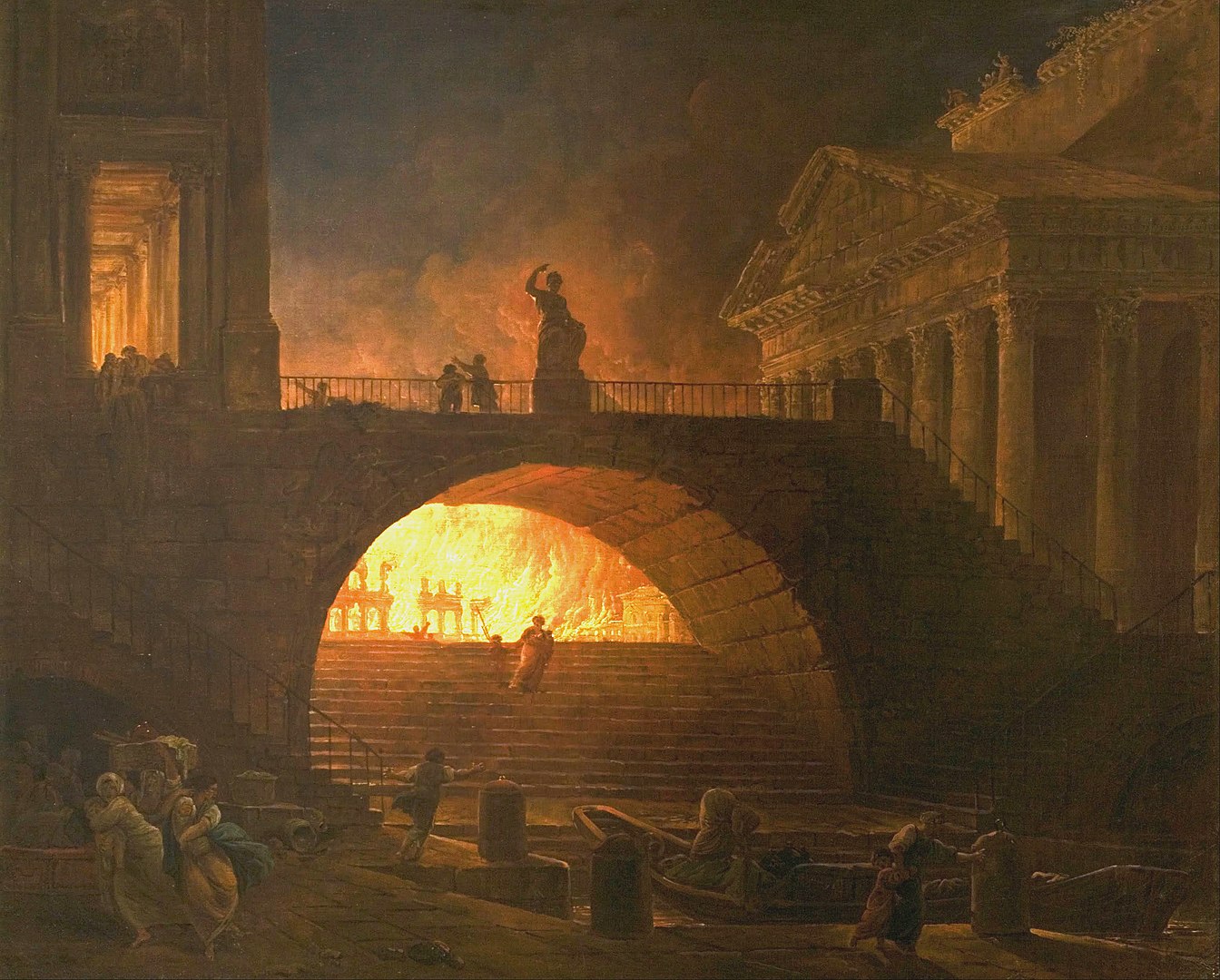Just on the edge of the sea at Anzio’s town sits a gigantic statue of the Roman emperor Nero. The only monument to a figure mostly scandalized in history. The one upon which, among cruel crimes, the burning of Rome is pinned. Modern historians refute these claims saying that the atrocities and obscenities associated with Nero are mostly fabricated, a work of jealous opponents and critics of the emperor.
Often it is claimed that Nero was seen playing the fiddle while the city was being overtaken by the blazing inferno that raged for nine days in the July of 64 AD.
Flame to Blaze
It all started on the evening of the 19th day of the month when the shopkeepers were going back to their abodes after wrapping things up. The night was silent. Only the howl of wind could be heard. It was just the opposite of a busy daytime during which the thundering voices of the crowds from the Circus Maximus, the famed chariot-racing stadium, overwhelmed other noises.
Somewhere in the dark night, a solitary flame rose, growing bigger and bigger, until it transformed into a big inferno that ultimately changed the fate of the city. There is no accurate explanation for what started the fire, but, as history witnessed, it spread wildly from one shop to another, to homes and buildings, even engulfing on its way the wood structure of the Circus Maximus. It thrashed the houses of the poor, and nature didn’t spare the wealthy. Upon reaching Palatine Hill, where the aristocrats and members of the royal family lived, it destroyed everything and kept moving. Upon reaching the lower regions of the city, it caused the most damage in the poor neighborhoods.

Just like the acclaimed Tacitus, ancient historians pointed fingers at Nero, accusing him of being the culprit who wanted to overpower the Senate and clear some area in the city to build a spectacular one-of-its-kind palace. Archaeologist Andrea Carandini has done research on the matter by digging in the city for almost twenty years. He studied the ‘ancient layers of ash’ left behind the fire and concluded that “everything was destroyed,” and not a single house was left standing. He says that it affected the Forum, the working/housing place of the senators, and the aristocracy ended up almost homeless. The mall in the middle of the Forum was later transformed into an area for commercial use, which indicated the end of those in power. Eric Varner is an art historian who says that “It seems unlikely that Nero would have started the great fire of AD 64 because it destroyed his palace, the Domus Transitoria … a huge, villa-like complex that stretched from the Palatine to the Esquiline.”
Others have also labeled it be an accident because minor fires were pretty common in Rome, and one of those could have easily transformed into a blaze given the fragility of things in those days. The slums were shabby and made of timber frames, but the senators’ houses were stony and strong. According to Tacitus, arson is the only explanation for how the fire crossed them. His statements feature southeasterly winds calling for queer patterns.
But researchers have employed modern technology to check whether a small fire can really spread like that and do the damage or not. They recreated a replica of a big stony home that a wealthy person would own in those days, and sure enough, a small fire that was lit in a corner spread from one spot to another, destroying the whole thing at the end. The temperature was found to be a severe 1,100 degrees, and the ceiling was unable to withstand the heat, part of it collapsing just before it was put out. This certainly shows that fire really didn’t have any trouble ravaging through the gigantic houses.
There’s also an impression that the fire mostly raged in other areas before it came to the Forum. But excavations suggest otherwise. Archaeologists have found remains of nails that were broken off of the ceilings and ended up melted on the ground. Scorched metal and masonry pieces were also found, indicating that the fire was forceful and capable enough to cause a collision of the well-built roofs. Many coins were discovered in the Forum as well. This could be the fallen change of the people running out of the place amid the tragedy and implying that the spread was quick, providing very little time to make a run for it. As for the pattern of winds, modern studies have shown that large fire rises higher in a current and yearns for more oxygen leading to a wider spread. The Palatine hills provided just those conditions.
Several excavations started in 1981 and onwards, where excavators found more evidence about the impact and scale of destructions. Among the findings were the pieces of Doric frieze, a section of order in the Roman architecture, that was without a doubt, burnt by the fire and the steps of a temple present at a corner of the Palatine. There were grates and bricks affected by heat, leftovers of carbonized wood, burned items of pottery and metal objects, and various other household items.

Aligning Fiction to Facts
It is said that Nero was not in Rome when the fire broke out and rushed to the city, joining the fire brigade’s attempts to put the blaze out. This is certainly a contrast to the other accounts of him rejoicing and watching the city burn from afar. It is now almost proven that the idea of ‘fiddling’ isn’t possible, for Romans didn’t use them back in the day.
We also find our liberties, for choosing the truth, in constraints; whether early historians coming from that period were making things up or are the explanations by modern archaeologists devoid of key proofs. What about Nero, the bad boy, himself? He is said to have put all the blame on Christians. Again, scholars are divided on the opinion. Christians of that time have been found to circulate and spread texts that foretell about a great fire that is destined to destroy the city. Gerhard Baudy, a Professor at the University of Konstanz, explained that the oracles constantly featured this theme, which became a desire inculcated in those who felt oppressed by the state. There was also this Egyptian prophecy that forecasted the fall of Rome on the day that the star Sirius rises, which happens to be July 19th. Baudy is of the view that this date went on to have a meaning attached in the minds of some Christians, who might have let go of their passions in an attempt to make it come true.
Fault Lines
How Nero handled the aftermath of the fire was a decisive factor in establishing his disputed reputation. The financial crisis that followed was one of the worst of that era, and its effects lasted for years. Nero taxed the provinces, and the money from the pockets of the aristocracy drained out fast. He also amended the quality of the coins, making them 80% silver and using copper for maintaining the rest of the weight. The evidence in this regard was discovered by scientists recently, who employed micro-drills to get samples of the coins. Nero did this in order to spare money for his new grand projects.
The consequence of his taxation policies created a gap between him and the elite class. They loathed him for making them pay to rebuild the city, especially the grand plan for Domus Aurea (Golden House). These factors, along with the declining value of the currency, made them turn against him and spew fabricated stories that tarnished any legacy he might have held in the coming years. Of course, there were some bits of truth in it as well. It is known, for a fact, that he murdered his mother, younger stepbrother, his cousin, and his ex-wife, among others.
Still, in the eyes of the ordinary folks, Nero was dear, for he announced plans to make modern building projects and schemes of employment, all the while refusing aid to the aristocrats affected by the fire. This lack of attention was a scandal for some and laudable for others. He celebrated the ordinary Romans and endeared the general public. Many think that it was more of an attempt at populism than humility.
It wasn’t just Nero who benefited from the land cleared by the fire. Those after him kept launching big projects in the open spaces, erecting the Colosseum, The Baths of Titus, the Temple of Peace, etc. Because the remains and earth fill amassed, the level of the area was also increased, allowing newer types of construction projects.
A Lifelong Blame Game
Nero, unaffected by the rumors against him, found the scapegoats in Christians. This persecution would last for ages. He ordered gruesome executions, which included being eaten alive by dogs, among other horrific sentences. Not only that but, it is also said that he mingled with the audiences while the sentences were being executed as a spectacle in front of the public.

He was just a boy of 15 when he sat on the throne. Undoubtedly, assuming power at such a stage can have varying consequences. He matched with other teen emperors in possessing the quality of being bold and bloody. He was the last of the Julio-Claudin dynasty, and after him, the throne would be won by competitions. The fire brought a new era of Roman architecture and lifestyle, cementing it as an important position in the running course of history.
Though much revered by the public, Nero did not have a respectable death and, during a military coup, took his own life four years after the great fire. The marvels that he erected, including The Golden House, did not last for long, and his legacy was destroyed in no time by jealous commentators.
There used to be a 103 feet bronze statue celebrating Nero near the Colosseum (for reference, the Statue of Liberty is 111 feet). But today, only the marble inscription marking the spot is left, mostly ignored by the 10,000 daily visitors of the Colosseum. Unlike other things, the emperor was unable to carve out his destiny. No heroic endings. Just prevarications around life, death, and even the heritage.
Read: Unraveling the mystery of Persian princess – a murder victim

Maham Maqsood is a science communicator and co-founder at Scientia Pakistan. She is currently doing Masters in Biochemistry at the Middle East Technical University, Turkey. She has over five years of experience in science communication and outreach, collaborating with researchers, educators, and communicators to develop effective strategies and content for various platforms and events.

